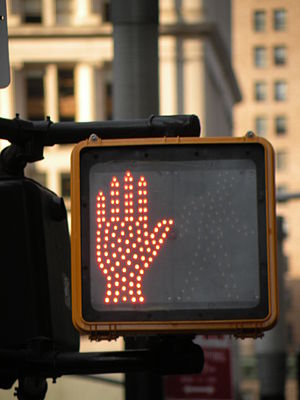Independent Living: Is Crossing the Street as Easy as ‘Look Left, Look Right, Look Left Again’?
Being independent requires being able to navigate the community safely. What are some tips?

Prepare to be aware of the environment. The first step in community safety is to be aware of our environment. This means putting away the earbuds and watching where we are walking. If a person tends to follow others when walking, she or he is not being challenged to pay attention to what is in the immediate vicinity or make decisions about which way to turn. She is not increasing her independence. Encourage your child to walk with you, or to take a turn in leading the group. This may involve reading signs and maps, so she is practicing functional academics as well.
Independence when walking in different environments includes watching for cars, people, and boundaries. Today I’ll discuss car safety.
Practice Various Scenarios
Car safety includes crossing streets and walking through parking lots. Try various neighborhoods that include a traffic light, not using a traffic light, and using a crosswalk. Intersections with T intersections, one-way traffic, forked roads, and three way intersections vary in terms of traffic flow. It’s not only a matter of the “look left, look right, look left again” strategy of crossing streets. It may also require looking behind you to see if a car is approaching and getting ready to turn right into your path. It may involve watching for cars waiting to turn left. Point out the turning signal on cars and see if your child notices that a driver is planning to turn, and which way.
Stand Back from the Curb
While watching traffic, stay a few feet away from the curb. Think about where you would fall if you tripped or if someone bumped you from behind. What if a car turned the corner too sharply and came up on the curb? Stay back about three feet from the road, but be ready to start walking briskly when it’s time to cross.
Being Independent Includes Being Proactive: Watch for Distracted Drivers
Even though cars are supposed to give right-of-way to pedestrians, sometimes they don’t. If it’s in an area where there is not a lot of pedestrian traffic, they may not be paying a lot of attention. They may be talking on their phone. Walkers need to be aware and make eye contact with the driver before stepping into the street. We all need to take responsibility for safety.
Social Skills: When a Driver Stops For You, Say Thanks
A note on social skills in dealing with drivers: if a driver stops for you to cross, make eye contact and hold your hand up to say ‘thank you’ as you begin crossing the street.
Navigating Parking Lots Safely: Plan, Watch, and Listen
How about parking lots? Cars are backing up, coming from two directions, and cutting across the parking lot. Practice watching for the backup lights. Again, drivers should give right-of-way to pedestrians, but they may not see people walking, or they may not look. It’s important for us as walkers to watch out for ourselves.
- There are more choices in terms of where to walk and where to cross to get to the building and back to our vehicle. A short discussion in the parking lot, planning out a route, develops independent skills.
- This is a good time to talk about using our ears and our eyes. Sometimes we may hear a car coming before we turn our head to see it. This is why we take off our headphones before we get out of the car or off the bus. It’s the safe thing to do.
When you think about it, walking in the community includes a lot of decision-making. Practice on an ongoing basis helps to build independent living skills.
Smart Steps LLC (c)2013
Related articles
- Rapid City Police launch pedestrian safety campaign (rapidcityjournal.com)
- Teach Your Preschooler How to Drive (jeanknowscars.com)

I saw your post left @ the Katie Couric website. I have a son that has been blessed with the gift of playing music. He is always working with somebody and considers these times the highlights of his life. He channels so much into the practice of playing that he only has occasional shows of being unfocused and irritated. It still comes up on performance write ups @ work, but has not caused him to lose a job. I am doing some research on vitamin supplements to aid him. He has never agreed to prescriptions. I found that melatonin could help. I can slip things in as long as I can show a vitamin bottle.
Laura,
Thanks for the comment. I’m glad that your son has found music and I’m sure that the rhythm helps to keep his system in balance. I also learned about a CD that helps with sleep. It’s called Dreaming in the Land of Can by Joe Romano, recorded at Cool Cat Studios. When I find the website I will post it.
On another note, I heard an M.D. speak last week at the Autism Society national conference; he uses blood tests to determine vitamin levels and recommends those before he even considers drugs, so I think you are on target.